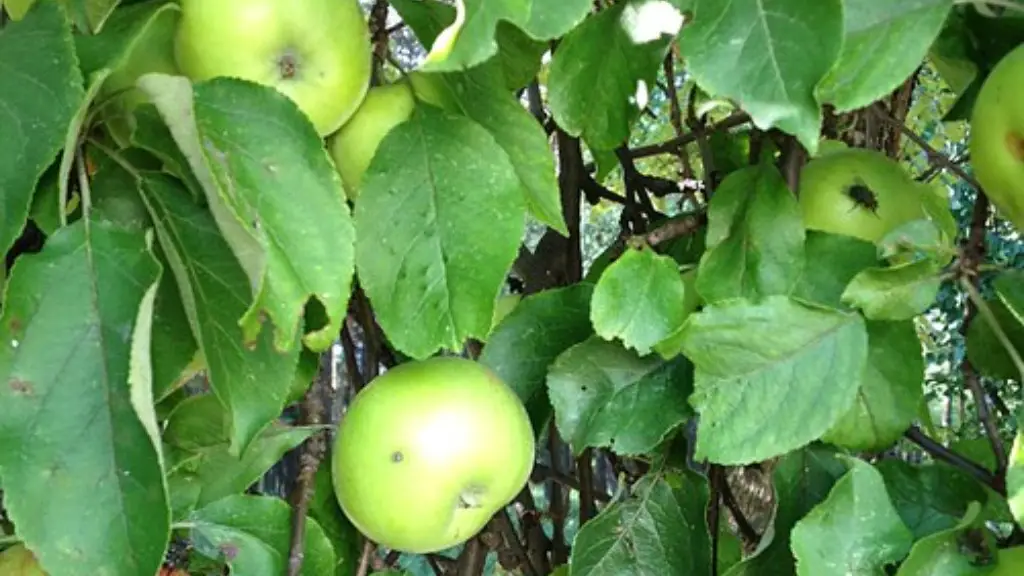Planting an apple tree is a long term investment in your landscape’s future. Knowing which type of tree to plant is essential to achieving the desired outcome. Before you select your apple tree, several factors should be taken into consideration.
The first consideration is the climate that the tree will be living in. Apples trees require a minimum temperature of 32 degrees Fahrenheit and thrive in climates with a semi-arid plant hardiness zone. Researching the local climate and your specific property’s climate before deciding on an apple tree can help ensure the tree’s success.
The apple tree’s rootstock plays an integral role in size and growth habit. Certain rootstocks can dwarf the tree by limiting size, while others will give it a more vigorous growth habit. Choosing the right rootstock for the available space, as well as preference for mature tree size, is essential for success.
Pest and disease resistance are also important considerations when choosing an apple tree. Certain types of apples are resistant to certain pests and diseases, but others are more vulnerable. Doing research on the pest and disease history in the area and selecting an apple tree that is resistant or immune to the main pest and disease threats can help ensure the tree’s survival.
Once your tree is planted, annual pruning, fertilization, and pest monitoring are all essential to keeping a healthy apple tree. Pruning and fertilization should be done according to the tree’s growth habit and size and as recommended by the local extension office. Regular pest monitoring should be done according to the tree’s particular symptoms and as recommended by the local extension office.
Choosing the right apple tree for your landscape is a big decision, but one that will pay off with delicious and healthy fruit for years to come. Researching the apple tree available in the local climate, selecting an appropriate rootstock, considering pest and disease resistance, and committing to regular pruning, fertilization, and pest monitoring are all essential for successful apple tree planting.
Climate Considerations
Climatic considerations are important when selecting the right apple tree for your landscape. Different apple varieties exist that are suited to different climates and a tree that is suited to a certain region will produce better fruit and be healthier overall. Apple trees are best suited to mild climates with long growing seasons such as USDA Plant Hardiness Zones 6-9. Planting apple trees in a location with a climate outside of these zones may result in poor fruit production or even death of the tree.
It is also important to research local microclimates and select a variety that is most suited to the specific climate on your property. For example, some apple trees are more susceptible to frost and freezing temperatures than others, and these should be avoided in regions with cold winters. By researching the local climate before selecting an apple tree, you can ensure that you select a variety that will produce well and stay healthy for many years.
Finally, it is important to pay attention to the time of year when planting an apple tree. Apple trees should be planted in late winter or early spring in order to have time to establish themselves before the heat and drought of summer. Planting in the late fall or winter can limit the tree’s access to sunlight and keep it from establishing a vibrant root system. Planting an apple tree with these climatic considerations in mind will greatly increase the success and life expectancy of the tree.
Rootstocks
Rootstocks play an important role in the size and growth habit of any apple tree. Apple trees on the appropriate rootstock can reach heights of up to 25 feet, while dwarf rootstocks will limit the size to a more manageable range of 8-12 feet. By selecting the appropriate rootstock for the space available, it is possible to tailor the size and growth habit of the tree to fit any landscape.
Apple rootstocks also influence the hardiness and cold-tolerance of the tree as well as its susceptibility to pests and diseases. Certain apple rootstocks are more resistant to pests, insects, and disease than others, and selecting a rootstock that is immune or resistant to specific threats is essential for success. Researching the local pest and disease threat before selecting a rootstock is essential for selecting a tree that will remain healthy and pest free.
Rootstocks also influence the fruit production of an apple tree. Some apple rootstocks can increase the production of fruit, while others will reduce yield. Selecting a rootstock that is suited to the desired yield will help ensure a bountiful harvest for years to come.
Rootstocks can be tricky and selecting the wrong one can lead to poor performance, poor hardiness, or even death of the tree. Doing research on the available rootstocks and choosing one that is suited to the local environmental and pest threats, hardiness, size desired, and desired yield can help ensure the success of your apple tree.
Pest and Disease Resistance
Pest and disease resistance is an important consideration when selecting apple trees. Certain areas have a higher risk of pests and diseases that can damage and even kill trees, and selecting a variety that is immune or resistant to these threats is essential. Common threats in some areas, such as fire blight and apple scab, can be easily avoided by selecting a variety that is resistant to those threats.
In addition to researching the specific pests and diseases in the area, it is important to research the tree’s susceptibility to other pests and insects such as mites, aphids, and borers. These pests can easily infest a tree if the right variety is not chosen for the area, and thus should be taken into account when selecting an apple tree. By researching the local pest and disease threats and selecting a variety that is resistant to them, apples can remain healthy and disease and pest free for many years.
Finally, it is important to select an apple tree that is easy to care for and maintain. Some apples require intensive annual pruning and fertilizing to remain healthy, while others can be left alone for many years. Choosing a variety that has minimal care requirements is essential for those who do not have the time or energy to dedicate to regular pruning and fertilizing.
By researching the local pest and disease threats and selecting a variety that is immune or resistant to specific threats, you can ensure that your apple tree will remain healthy and pest free for years to come.
Annual Maintenance
Annual pruning and fertilization are essential for maintaining the health and productivity of an apple tree. Pruning an apple tree should generally be done in late winter or early spring, and should be done according to the growth habit and size of the tree. Pruning too heavily can limit the yield of the tree, while not pruning enough can lead to overgrown and unproductive trees.
Using fertilizers with specific nutrients for apple trees is also important for maintaining the health of the tree and promoting fruit production. When selecting a fertilizer, it is important to make sure that it includes the necessary micro and macronutrients for apple trees. Different apple trees require different fertilizers, and it is important to research the specific fertilizers for the chosen variety.
Pest monitoring and control is also essential for a healthy apple tree. Most apple trees can benefit from the application of pest prevention and repellants, and regular monitoring is essential to ensure that pests are kept in check. Regular spraying and monitoring can help prevent a pest outbreak that could devastate an apple tree.
By committing to regular pruning, fertilization, and pest monitoring, you can ensure that your apple tree will remain healthy and productive for years to come.
Conclusion
Choosing the right apple tree for your landscape is an important decision with many considerations. Researching the local climate and selecting a variety native to the area is essential for success. Selecting the right rootstock to match the desired size and growth habit is also essential. Researching the local pest and disease threat and selecting an apple tree that is resistant or immune to them can help prevent pest and disease outbreaks. And finally, committing to regular pruning, fertilization, and pest monitoring can help ensure the health and longevity of the tree. By researching and considering all of these factors when selecting an apple tree, you can ensure that your apple tree will produce sweet, healthy fruit for years to come.

